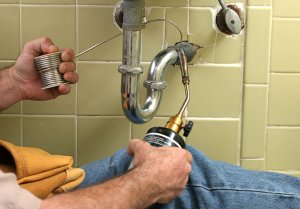
Plumbing problems! Almost all are frustrating and more often than not, come as a surprise. Many don’t know, however, that some of the most common plumbing problems can be fixed relatively easily without the need of calling in a plumber. Check out the five most common plumbing issues listed below to determine if you want to attempt a DIY job or make that phone call.
1. Clogged Drains or Toilet
When it comes to plumbing issues, one of the most common that everyone encounters is a clogged toilet or pipe. Various methods can be used to address this issue. The use of a plunger probably needs no further explanation, whether one sized for a toilet clog or a smaller version that can be used for a kitchen sink. However there are a few other tools that can be used for heavier duty jobs. A snake tool typically can assist with heavier clogs since it can easily maneuver through the twists and turns of most pipes. The use of a liquid de-clogger can be helpful to dissolve debris and is safe for most pipes, however, over use of this method can break down the inner lining of the pipes so use with caution. Once a clog is removed, a great preventative measure to insure that there will not be a recurrence is to install a protective drain screen to catch debris before there is a problem.
2. Running Toilet
A running toilet in addition to being a nuisance, can indicate that a part of the toilet is over worn or not running properly. First, check inside the tank to see if the problem originates there. Typically, you may need to replace the fill valve, the flush valve seal, or the flush valve. All parts can be found at your local hardware store and can easily be replaced with a standard set of wrenches. If, however, these parts have been replaced recently or are new, you may have a sediment issue on your hands, that’s affecting proper flushing and filling. An increase in your monthly water bill could be an indicator that this is the case. At this point, calling in a professional may be the next step.
3. Dripping Faucet
A dripping faucet can also be a relentless nuisance, not to mention wasteful. Typically, if the drips reoccur even after you’ve tried turing the faucet on and off several times, the washers have deteriorated to the point of needing replacement within the faucet head. Unfortunately, not all faucet heads are the same and may need specialized tools or parts. Sometimes, the only way to know for sure is to take the faucet head apart to see what parts need to be replaced. This can get tricky with many different outcomes, so unless you feel confident in your plumbing abilities, calling a professional may be the best course of action for this one.
4. Leaky Pipes
First of all, repairing a leaky pipe tends to be a messy job, so to minimize stress, make sure to shut-off your main water supply first. Most leaky pipes are the result of a damaged, or worn seal, or a crack in the actual pipe. Determining where the source of the leak is, will help you decide if you want to tackle the issue yourself or call in a professional. More often than not, leaks occur at a joint, so finding commercial joint fitters or fitting compounds is easy enough at your local hardware store. When replacing, make sure to allow the pipe to dry completely and seal the new pieces with waterproof sealant and tape.
5. Low Water Pressure
This plumbing issue is actually an easier fix than most people think. Typically, most experience low water pressure at the kitchen sink and a simple removal and clean out of the faucet’s aerator in a vinegar solution will solve the problem. If the water pressure is affecting the shower head or bathroom faucet, affixing a bag with vinegar to the heads overnight will most likely solve your issue. If these steps have been taken and the water pressure is still low, then there may be a more serious issue in your pipes that you may want a professional to come and take a look at.
Hopefully, the above tips provide some initial guidance to the most common plumbing issues that many people face. Remember, when in doubt, always call in a professional if you are not confident in how to solve the problem. Good luck!
Sources:
http://plumbing.about.com/od/basics/tp/Common-Plumbing-Problems-And-How-To-Fix-Them.htm
